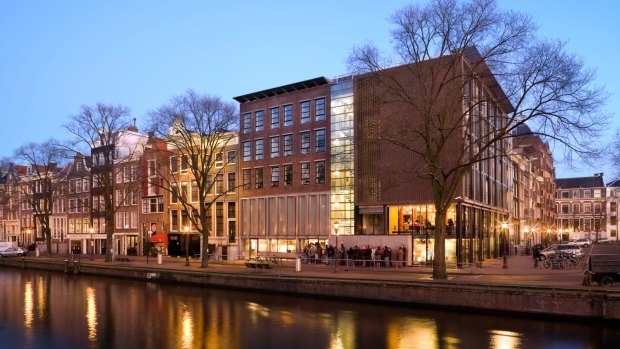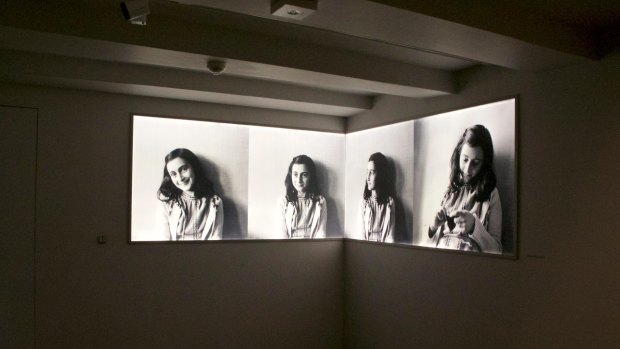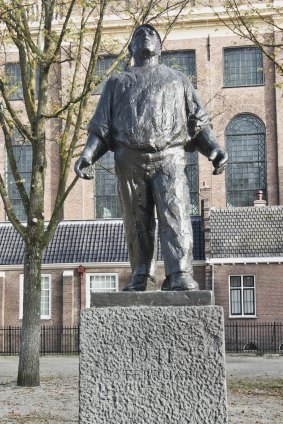This was published 5 years ago
Anne Frank House and Museum: Amsterdam remembers dark times under the Nazis

Anne Frank House and Museum on the Prinsengracht Canal in Amsterdam.Credit: Alamy
On a bitterly cold New Year's Day in Amsterdam, 30 international tourists gather outside the city's Jewish Historical Museum.
Smashed glass litters the city centre like a scene from Reichskristallnacht, the "Crystal Night" of November 1938, when Jewish businesses in Nazi Germany were destroyed in a pogrom that led eventually to the Holocaust.
Fortunately, this morning's debris is benign.

Photos of Anne Frank at Anne Frank House Museum in Amsterdam.Credit: Alamy
Amsterdam goes crazy each New Year's Eve, setting off private fireworks and littering beer and champagne bottles.
Anne Frank is one of the 20th century's most famous people. The lively Jewish teenager, her family and friends spent two years hiding from the SS in "a secret annex" behind a 17th century house on a canal named after the Prince of Orange.
Betrayed in 1944, Anne, her sister and mother died in the concentration camps. Only Anne's father, Otto, survived Auschwitz, finding the diary his teenage daughter had hidden when he returned to Amsterdam.

This sculpture in Amsterdam commemorates the bravery of dockworkers striking in protest at deportations of Jews.Credit: Alamy
Her heavily edited diary (with teenage traumas removed) was published in 1947. Otto was then persuaded to open Anne Frank House to the public in 1960.
Today, 2 million tourists a year visit the hugely expanded Anne Frank Museum, unveiled by Queen Beatrice in 2001.
"But Anne wasn't the only teenage girl in the Netherlands to suffer such a fate," says our guide, Josje as we split up into two groups of 15 and begin a walking tour of the Jewish Amsterdam Anne knew before she went into hiding.
"There were 140,000 Jewish men, women and children living here in 1940."
Unlike Belgium, the Netherlands had been neutral in World War I. It was also neutral in World War II, but Hitler's forces invaded anyway on May 10, 1940.
"This is not a pretty story," Josje continues. Dutch collaborators welcomed the Stormtroopers into Damrak (Amsterdam's equivalent of London's Trafalgar Square).
Between February 1941 and September, 1944, 104,000 Jews were deported from the Netherlands. Only 5200 survived.
Yet until the Nazi invasion, Amsterdam had been one of the most Jewish-friendly cities on earth. The Jewish Historical Museum lies in the heart of the old Jewish quarter, Josje explains. Jews had lived here for centuries, particularly after the Spanish Inquisition drove them from Spain and Portugal. Directly across the street lies the Portuguese synagogue, built in 1675.
"Amsterdam was a merchant city and Jewish businessmen fitted in quite naturally," Josje continues. "But lots of non-Jews lived in the Jewish quarter as neighbours – including Rembrandt."
Otto Frank moved his German-Jewish family to Amsterdam as soon as Hitler was elected German chancellor in 1933. Anne was five. For a time the Frank family fortunes prospered.
But once the Nazis invaded, Jews were made to wear the yellow star, and have their documents marked with J (for Jew).
Things got infinitely worse in February 1941. Josje gathers us beneath a statue of "the dockworker", symbolising those who took part in a three-day strike known as the Februaristaking – the only mass protest against Jewish deportation organised by non-Jews in occupied Europe.
The trigger was the death of Henrik Koot – a member of the NSB (the Dutch Nazi Party) which had engaged in a number of violent street battles with dock workers and the banned communist party.
Koot, a street thug, was portrayed as a heroic martyr by the Nazi-dominated press. German soldiers, aided by Dutch police, erected barbed wire around the Jewish quarter.
That weekend, the Nazis arrested 425 Jews who were sent to the Dutch concentration camp at Vetterborg. Only two survived. Sixteen non-Jewish "ring leaders" were executed.
The tour takes us to Wertheim Park (now home to the city's Auschwitz Monument), and finishes at the Anne Frank Museum.
Most of the Jewish deportations from Amsterdam took place between 1941 and 1943.
On a brighter note as befits New Year's Day, Josje reminds us some Dutch people risked their own lives to help the Jews.
Around 250 Jewish children were rescued by non-Jewish members of the Dutch Resistance.
They persuaded Jewish parents about to be sent to the concentration camps to hand over children young enough to fool the Nazis.
Imagine the trauma to parents, children and rescuers.
TRIP NOTES
FLY
Several airlines offer a single-stop from Sydney (sometimes Melbourne and Brisbane) to Amsterdam. These include Etihad/KLM, see etihad.com/en-au/; Qantas/China Airlines, see qantas.com/au; and Garuda Indonesia (via Jakarta), see garuda-indonesia.com/au
VISIT
Anne Frank Museum, see annefrank.org. (Timed tickets, book in advance).
TOUR
360 Amsterdam is one of several companies which run tours of Jewish Amsterdam, see 360amsterdamtours.com
MORE
Steve Meacham travelled at his own expense.
Sign up for the Traveller Deals newsletter
Get exclusive travel deals delivered straight to your inbox. Sign up now.